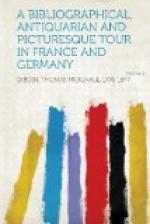There is, in fact, no proper approach to this interesting edifice. The western end is suffocated with houses. Here stands the post-office; and with the most unsuspecting frankness, on the part of the owner, I had permission to examine, with my own hands, within doors, every letter—under the expectation that there were some for myself. Nor was I disappointed. But you must come with me to the cathedral: and of course we must enter together at the western front. There are five porticos: the central one being rather large, and the two, on either side, comparatively small. Formerly, these were covered with sculptured figures and ornaments; but the Calvinists in the sixteenth, and the Revolutionists in the eighteenth century, have contrived to render their present aspect mutilated and repulsive in the extreme. On entering, I was struck with the two large transverse Norman arches which bestride the area, or square, for the bases of the two towers. It is the boldest and finest piece of masonry in the whole building. The interior disappointed me. It is plain, solid, and divested of ornament. A very large wooden crucifix is placed over the screen of the choir, which has an effect—of its kind: but the monuments, and mural ornaments, scarcely deserve mention. The richly ornamented arches, on each side of the nave, springing from massive single pillars, have rather an imposing effect: above them are Gothic ornaments of a later period, but too thickly and injudiciously applied. Let me now suppose that the dinner is over, and the “vin de Beaune” approved of—and that on a second visit, immediately afterwards, there is both time and inclination for a leisurely survey. On looking up, upon entering, within the side aisle to the left, you observe, with infinite regret, a dark and filthy green tint indicative of premature decay—arising from the lead (of that part of the roof,) having been stript for the purpose of making bullets during the Revolution. The extreme length of the interior is about 320 English feet, by 76 high, and the same number of feet in width. The transepts are about 125 feet long, by 36 wide. The western towers, to the very top of the spires, are about 250 English feet in height.
One of the most curious objects in the Cathedral, is the CRYPT; of which, singularly enough, all knowledge had been long lost till the year 1412. The circumstance of its discovery is told in the following inscription, cut in the Gothic letter, upon a brass plate, and placed just above the southern entrance:




